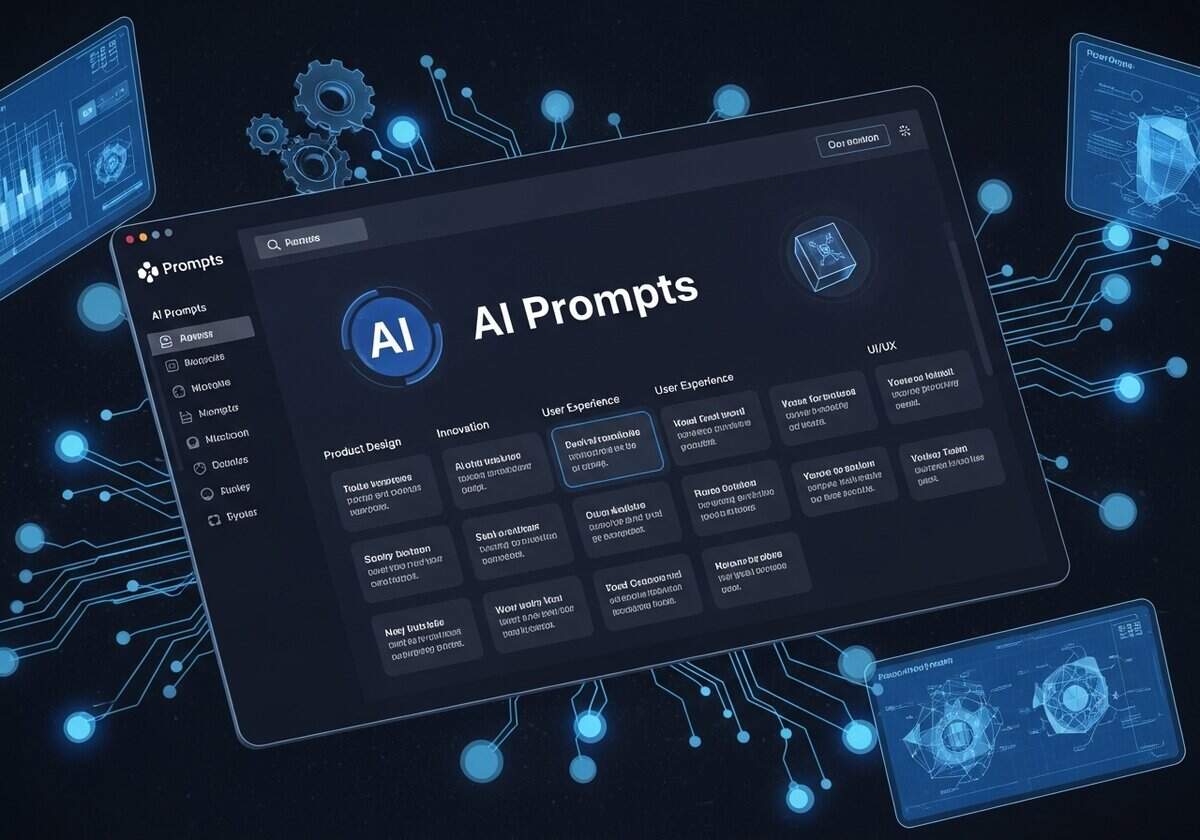产品设计与创新领域最大的人工智能提示目录

欢迎访问全球最大的人工智能提示目录,该目录致力于先进的产品设计、工程、科学、创新、质量和制造。虽然在线人工智能工具正在通过增强人类能力迅速改变工程领域,但其真正的威力是通过精确和专业的指令来释放的。本综合目录为您提供了一系列此类提示,使您能够指挥人工智能系统处理海量数据、识别复杂模式并生成新颖的解决方案,其效率远远超过传统方法。
发现并微调所需的准确提示,利用在线人工智能代理优化设计,以达到最佳性能和可制造性,加速复杂模拟,准确预测材料特性,并自动执行各种关键分析任务。
通过高级搜索过滤器可以快速访问这个内容广泛的目录,涵盖现代工程学的所有领域。
- 假设的产生
人工智能提示 Hypothesize Causes of Catalyst Deactivation
- 化学品回收, 故障分析, 材料科学, 流程改进, 质量控制, 质量管理, 根本原因分析, 可持续发展实践
This prompt generates plausible hypotheses explaining catalyst deactivation based on a list of observed symptoms such as activity loss, selectivity change, and physical catalyst changes. The AI provides a ranked list of hypotheses with brief mechanistic explanations.
输出:
- Markdown
- 不需要实时互联网
- Fields: {list_of_symptoms}
- Best for: Generate mechanistic explanations for catalyst failures
- 代码生成和调试
人工智能提示 Generate C++ Code for Heat Exchanger Design
- 面向制造设计 (DfM), 活力, 环境工程, 流体力学, 热处理, 机械工业, 工艺优化, 可持续发展实践, 热力学
This prompt generates a C++ program to calculate heat exchanger parameters such as heat transfer rate, log mean temperature difference, and required surface area based on user inputs of fluid temperatures, flow rates, and heat capacities. The code is fully commented and ready for compilation.
输出:
- C
- 不需要实时互联网
- Fields: {inlet_temp_hot} {outlet_temp_hot} {inlet_temp_cold} {flow_rate_hot}
- Best for: Automate heat exchanger design calculations
- 代码生成和调试
人工智能提示 Generate Python Code for Reaction Rate Calculation
- 化学品回收, 化学, 环境工程, 环境影响, 工艺优化, 产品开发, 质量管理, 可持续发展实践, 热力学
This prompt creates a Python script to calculate reaction rates based on Arrhenius kinetics, given user inputs of activation energy, pre-exponential factor, temperature, and concentration. The code includes comments and example usage, facilitating integration into chemical engineering workflows.
输出:
- Python
- 不需要实时互联网
- Fields: {activation_energy} {pre_exponential_factor} {temperature} {concentration}
- Best for: Generate reusable code for kinetic calculations
- 数据生成或扩充
人工智能提示 Create Catalyst Property Variations
- 增材制造设计(DfAM), 机器学习, 预测性维护算法, 流程改进, 质量管理, 统计分析, 可持续发展实践, 可持续产品设计
This prompt generates plausible variations of catalyst property data given an initial dataset in CSV format. It outputs an augmented CSV with new catalyst entries created by applying small random perturbations to surface area, pore volume, and metal loading, useful for training robust machine learning models.
输出:
- CSV
- 不需要实时互联网
- Fields: {catalyst_properties_csv}
- Best for: Expand catalyst datasets to improve model robustness
- 信息提取
人工智能提示 Retrieve Safety and Hazard Statements
- 化学品回收, 环境影响, 环境影响评估, 危險與可操作性研究(HAZOP), 流程改进, 风险分析, 风险管理, 安全
This prompt scans a provided chemical process description or material safety document to extract all safety and hazard statements, including precautionary measures and hazard codes. The output is a bullet-point list in plain text for easy review and compliance checks.
输出:
- 文本
- 不需要实时互联网
- Fields: {process_description}
- Best for: Rapidly gather safety and hazard info from process descriptions
- 信息提取
人工智能提示 Identify Catalyst Types and Properties
- 化学品回收, 环境影响, 环境技术, 材料, 工艺优化, 产品开发, 质量管理, 可持续发展实践
This prompt identifies all catalyst types mentioned in a given technical document excerpt and extracts their key properties such as surface area, pore volume, and active metal loading. The AI outputs a neatly formatted markdown table listing each catalyst and its properties to facilitate catalyst comparison and selection.
输出:
- Markdown
- 不需要实时互联网
- Fields: {technical_text}
- Best for: Quickly compare catalysts and their characteristics from technical documents
- 信息提取
人工智能提示 Extract Experimental Parameters from Text
- 化学品回收, 化学, 环境影响, 环境技术, 流程改进, 质量管理, 研究与开发, 可持续发展实践
This prompt extracts key experimental parameters such as temperature, pressure, catalyst type, and reaction time from a provided unstructured text excerpt of a chemical engineering report or paper. It outputs a structured JSON summarizing each parameter with its value and units, helping engineers quickly gather critical data without manual reading.
输出:
- JSON
- 不需要实时互联网
- Fields: {unstructured_text}
- Best for: Extracting precise experimental values from unstructured text for quick parameter overview
- 故障排除和诊断
人工智能提示 Troubleshoot Packed Column Flooding
- 化学品回收, 流体力学, 流程改进, 工艺优化, 质量保证, 质量控制, 风险管理, 可持续发展实践
A packed distillation or absorption column is experiencing flooding. Given column internals packing type fluid properties (gas/liquid loads) operating conditions and observed symptoms (e.g. high pressure drop entrainment poor separation) this prompt asks the AI to suggest causes and diagnostic checks.
输出:
- Markdown
- 不需要实时互联网
- Fields: {column_service_and_type} {packing_details} {fluid_properties_and_loads_summary} {flooding_symptoms_csv}
- Best for: Guiding chemical engineers in diagnosing flooding in packed columns by systematically linking observed symptoms (high dP entrainment poor separation) to potential hydraulic issues maldistribution packing problems or foaming based on operational data and system design.
- 数据生成或扩充
人工智能提示 Simulate Reactor SteadyState Yields
- 化学品回收, 化学, 增材制造设计(DfAM), 面向制造设计 (DfM), 流程改进, 工艺优化, 模拟, 可持续发展实践, 可持续产品设计
This prompt generates a conceptual table of expected product yields from a specified chemical reactor type under varying steady-state operating conditions (e.g. temperature pressure catalyst concentration). It relies on general chemical engineering principles and user-provided qualitative impact of conditions. This is for conceptual design or educational exploration not rigorous simulation.
输出:
- Markdown
- 不需要实时互联网
- Fields: {reactor_type} {reaction_stoichiometry_and_kinetics_qualitative} {conditions_to_vary_json} {base_yield_percent}
- Best for: Facilitating conceptual exploration of process variable impacts on reactor yield providing a basis for preliminary design discussions experimental planning or educational examples without needing complex simulation software.
- 信息提取
人工智能提示 Extract Catalyst Performance Data URL
- 化学品回收, 化学, 环境工程, 环境影响, 材料科学, 工艺优化, 研究与开发, 可持续发展实践
This prompt tasks the AI with scraping a given URL of a research article or patent that discusses catalysis. It should identify and extract specific data related to catalyst performance such as conversion selectivity turnover number (TON) turnover frequency (TOF) and reaction conditions under which these were achieved for a named catalyst or reaction system. The output is a JSON object.
输出:
- JSON
- 需要实时互联网
- Fields: {document_URL} {catalyst_name_or_system} {performance_metrics_list}
- Best for: Efficiently gathering catalyst performance data (conversion selectivity TOF/TON) and associated reaction conditions from online scientific publications or patents aiding in catalyst research and comparative studies.

































没有人讨论这些目录在人工智能选择方面可能存在的偏见吗?人工智能无法避免偏见,各位。